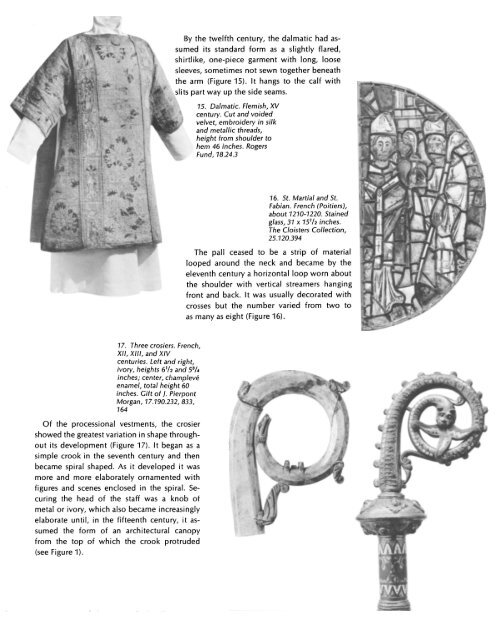The Metropolitan Museum of Art Bulletin, v. 29, no. 7 (March, 1971)
The Metropolitan Museum of Art Bulletin, v. 29, no. 7 (March, 1971)
The Metropolitan Museum of Art Bulletin, v. 29, no. 7 (March, 1971)
Create successful ePaper yourself
Turn your PDF publications into a flip-book with our unique Google optimized e-Paper software.
.<br />
By the twelfth century, the dalmatic had assumed<br />
its standard form as a slightly flared,<br />
shirtlike, one-piece garment with long, loose<br />
sleeves, sometimes <strong>no</strong>t sewn together beneath<br />
the arm (Figure 15). It hangs to the calf with<br />
,,slits part way up the side seams.<br />
15. Dalmatic. Flemish, XV<br />
century. Cut and voided<br />
velvet, embroidery in silk<br />
and metallic threads,<br />
height from shoulder to<br />
hem 46 inches. Rogers<br />
Fund, 18.24.3<br />
16. St. Martial and St.<br />
Fabian. French (Poitiers),<br />
about 1210-1220. Stained<br />
glass, 31 x 157/2 inches.<br />
<strong>The</strong> Cloisters Collection,<br />
25.120.394<br />
<strong>The</strong> pall ceased to be a strip <strong>of</strong> material<br />
metal orlooped around the neck and became by the<br />
eleventh century a horizontal loop worn about<br />
the shoulder with vertical streamers hanging<br />
front and back. It was usually decorated with<br />
crosses but the number varied from two to<br />
as many as eight (Figure 16).<br />
17. Three crosiers. French,<br />
XII, XIII, and XIV<br />
centuries. Left and right,<br />
ivory, heights 6/2 and 53/4<br />
inches; center, champleve<br />
enamel, total height 60 :<br />
inches. Gift <strong>of</strong> J. Pierpont<br />
Morgan, 17.190.232, 833,<br />
164<br />
Of the processional vestments, the crosier<br />
showed the greatest variation in shape through-<br />
'<br />
out its development (Figure 17). It began as a .,<br />
simple crook in the seventh century and then ~": /<br />
became spiral shaped. As it developed it was<br />
more and more elaborately ornamented with<br />
figures and scenes enclosed in the spiral. Securing<br />
the head <strong>of</strong> the staff was a k<strong>no</strong>b <strong>of</strong><br />
metal or ivory, which also became increasingly<br />
elaborate until, in the fifteenth century, it as- '-<br />
sumed the form <strong>of</strong> an architectural ca<strong>no</strong>py . I<br />
from the top <strong>of</strong> which the crook protruded<br />
(see Figure 1).<br />
.-.F,

















